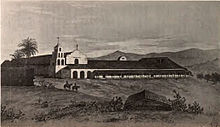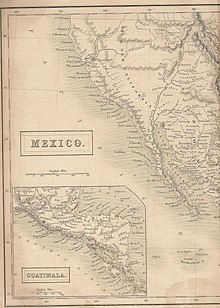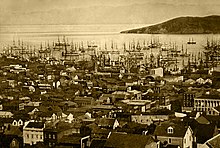Etymology
Main article: Etymology of California
The word California originally referred to the Baja California Peninsula of Mexico; it was later extended to the entire region composed of the current United States states of California, Nevada, and Utah, and parts of Arizona, New Mexico, Texas and Wyoming.[citation needed]The name California is surmised by some writers to have derived from a fictional paradise peopled by Black Amazons and ruled by Queen Calafia,[19][20] who fought alongside Muslims and whose name was chosen to echo the title of a Muslim leader, the Caliph, fictionally implying that California was the Caliphate.[21] The story of Calafia is recorded in a 1510 work The Adventures of Esplandián, written as a sequel to Amadis de Gaula by Spanish adventure writer Garci Rodríguez de Montalvo.[22][23][24] The kingdom of Queen Calafia, according to Montalvo, was said to be a remote land inhabited by griffins and other strange beasts, and rich in gold.
When Spanish explorer Francisco de Ulloa was exploring the western coast of North America, his initial surveys of the Baja California Peninsula led him to believe that it was an island rather than part of the larger continent, so he dubbed the "island" after the mythical island in Montalvo's writing.[26] This conventional wisdom that California was an island, with maps drawn to reflect this belief, lasted as late as the 1700s.[27]Know ye that at the right hand of the Indies there is an island called California, very close to that part of the Terrestrial Paradise, which was inhabited by black women without a single man among them, and they lived in the manner of Amazons. They were robust of body with strong passionate hearts and great virtue. The island itself is one of the wildest in the world on account of the bold and craggy rocks. — Chapter CLVII of The Adventures of Esplandián[25]
Shortened forms of the state's name include CA, Cal., Calif. and US-CA.
History
Main article: History of California
Pre-contact
Settled by successive waves of arrivals during the last 10,000 years, California was one of the most culturally and linguistically diverse areas in pre-Columbian North America. Various estimates of the native population range from 100,000 to 300,000.[28] The Indigenous peoples of California included more than 70 distinct groups of Native Americans, ranging from large, settled populations living on the coast to groups in the interior. California groups also were diverse in their political organization with bands, tribes, villages, and on the resource-rich coasts, large chiefdoms, such as the Chumash, Pomo and Salinan. Trade, intermarriage and military alliances fostered many social and economic relationships among the diverse groups.16th, 17th and 18th centuries
Mission San Diego de Alcalá drawn as it was in 1848. Established in 1769, it was the first of the California Missions.
Despite the on-the-ground explorations of California in the 16th century, Rodríguez's idea of California as an island persisted. That depiction appeared on many European maps well into the 18th century.[31]
After the Portolà expedition of 1769–70, Spanish missionaries began setting up 21 California Missions on or near the coast of Alta (Upper) California, beginning in San Diego. During the same period, Spanish military forces built several forts (presidios) and three small towns (pueblos). Two of the pueblos grew into the cities of Los Angeles and San Jose. The Spanish colonization brought the genocide of the indigenous Californian peoples.
19th century
The Russian Empire established their largest settlement in California at Fort Ross in 1812
Map showing Alta California in 1838 when it was a sparsely populated Mexican province.[32]
Merchant ships fill San Francisco harbor in 1850 or 1851
Chinese gold miners in California





No comments:
Post a Comment